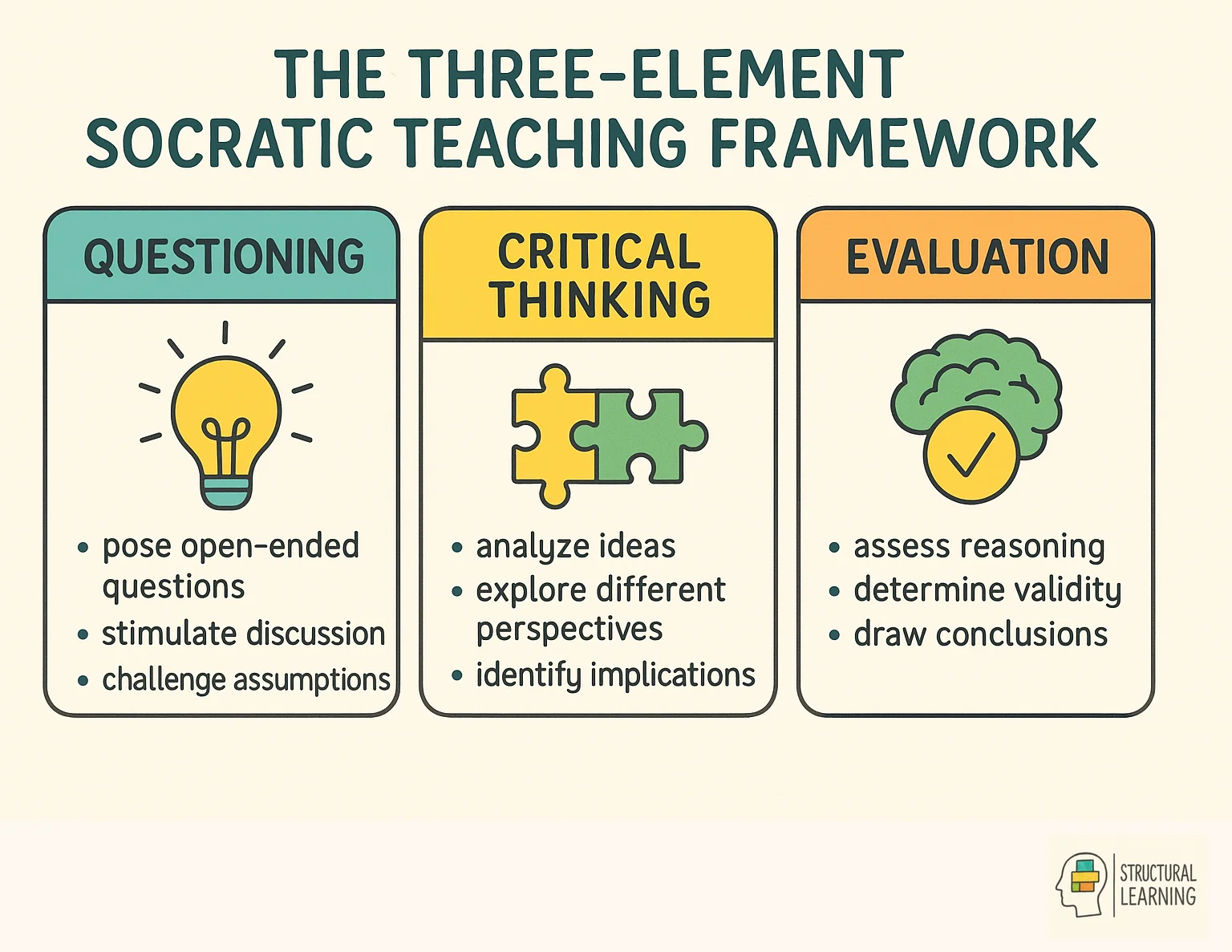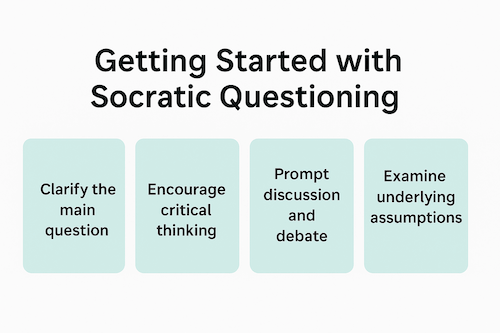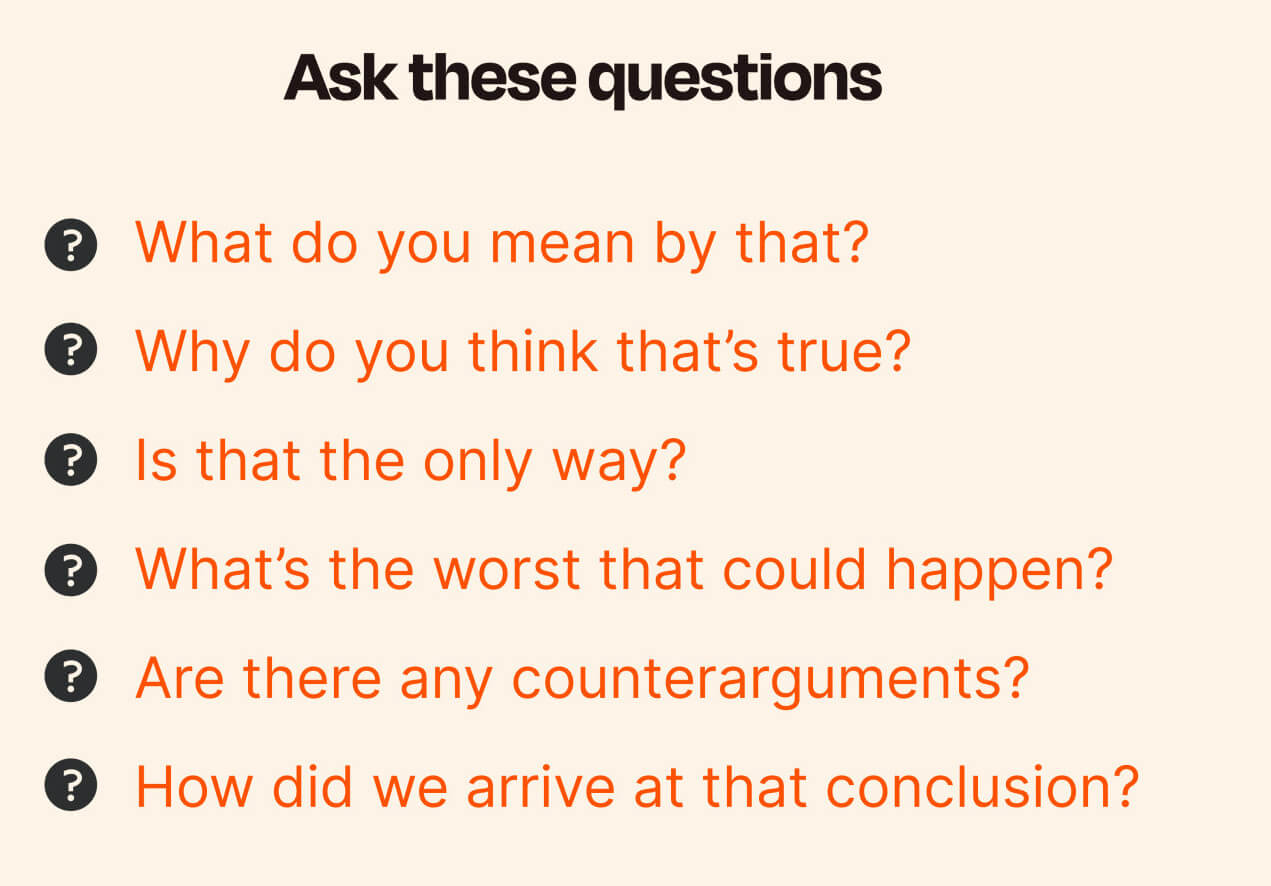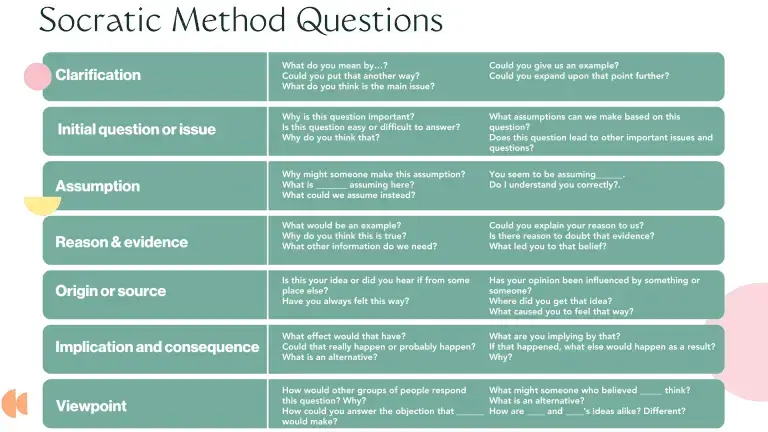Socratic Teaching Techniques for Effective Learning
Discover effective Socratic teaching techniques to enhance critical thinking and student engagement through open-ended questions and dynamic dialogues.


Discover effective Socratic teaching techniques to enhance critical thinking and student engagement through open-ended questions and dynamic dialogues.
The Socratic Process transforms your classroom into a space for productive discussion. This active learning technique uses well-designed questions to help students examine their thinking and build understanding through dialogue. You ask, students respond, and together you explore ideas that sit beneath surface-level knowledge.
This approach works across wide ranges of subjects and age groups. Students make claims with examples, test their reasoning, and experience productive discomfort as they question what they thought they knew. The method thrives on collaborative inquiry rather than direct instruction.

Three key elements make the Socratic Process effective in your classroom:
The technique originated with the Greek philosopher Socrates, who claimed to know nothing but used questioning to expose gaps in others' knowledge. Teachers today apply this method to help students think independently and critically about complex ideas.
Law schools rely heavily on Socratic questioning to sharpen analytical skills, but the method works equally well in primary schools, secondary classrooms, and any setting where you want students to think rather than simply absorb. The process requires patience and practice, yet the payoff comes when students begin asking their own probing questions and taking intellectual risks.

In essence, the Socratic method is a pedagogical approach that encourages students to engage in critical thinking and to discover answers by themselves through a series of methodical and reflective questions. Socratic questioning serves as a powerful tool to dissect complex ideas, delve into assumptions, and break down conceptual frameworks.
In the classroom, this technique prompts students to question their own knowledge and convictions, consequently fostering intellectual humility and the ability to scrutinize and refine their understanding. Moreover, the role of the teacher in this methodology shifts from being the conveyor of knowledge to a facilitator of dialogue, championing the art of inquiry over simply delivering content.
The process capitalizes on active learning, where students' insights unfold as they articulate responses to carefully crafted questions. Law schools, in particular, often employ this method to sharpen a law student's ability to analyze and argue effectively, evidencing the process's versatility across different fields of study.
The roots of the Socratic Process are firmly planted in the rich soil of ancient Greece, introduced by the philosopher Socrates as a way to challenge and expand the horizons of human understanding. Socrates himself claimed to know nothing, but through his skilled line of inquiry, he prompted those around him to reconsider their beliefs and the extent of their knowledge.
Teachers today bring this historical legacy into their classrooms by adopting Socrates's approach to draw out insights from students through a collaborative and open-ended dialogue. The method resists the notion of spoon-feeding facts; instead, it endeavors to bring forth an individual's innate wisdom and to channel it into a vigor for life-long learning.
This approach has stood the test of time for its effectiveness in promoting critical thinking and for empowering students to take ownership of their intellectual growth.
The philosophical principles of Bertrand Russell have played a pivotal role in shaping contemporary understanding and applications of the Socratic teaching method. Russell's philosophy, centered on the importance of questioning assumptions and underlying beliefs, complements the fundamental objective of the Socratic method, which is to challenge presuppositions and foster critical thinking.
Russell's contributions to the Socratic teaching method emanate from his persistent emphasis on critical thinking and inquiry-based learning. He championed the view that education should not merely be about the absorption of facts, but rather, a journey of exploration led by probing questions that challenge existing assumptions, thus stimulating rich intellectual dialogue.
Through his own teaching and writing, Russell underscored the utility of employing a discipline of questioning, much like Socratic questioning, to uncover latent presuppositions and encourage a deeper engagement with ideas. His influence has extended to educators who use the Socratic method, resonating with his philosophy that places cooperation and mutual understanding at the core of intellectual discourse.

Shifting focus to the more broad-reaching impact of Russell's philosophy on education, it becomes evident that his endorsement of the Socratic method aligns seamlessly with the aim of empowering students to become independent thinkers.
In the classroom setting, Socratic discussions informed by Russell's philosophies guide students to understand and grapple with complex ideas through carefully structured questions and collaborative observations. This method has been instrumental in educational institutions like Great Hearts, where literature and humane letters classes often engage with philosophical discourse and great texts using the Socratic approach.
Such dialogue-driven classes exemplify how the Socratic method remains essential for unearthing the deeper truths within texts and concepts while mitigating the risk of bias and misconceptions. Ultimately, the marriage of Russell's philosophy with the Socratic method promotes a culture of learning through rigorous questioning, encouraging students to think more deeply and embark on their own pathways of discovery, extending beyond philosophy into a plethora of scholastic domains.
Developing critical thinking skills is a cornerstone of educational progress and personal development. Through the strategic application of the Socratic method, students are encouraged to dive deeply into their belief systems, thoroughly examining the assumptions they hold about various topics. The process goes beyond mere surface learning or rote memorization; it involves engaging in a dynamic exploration of ideas that requires the learner to question, evaluate, and synthesize information.
This active participation is essential for effective learning, as research with undergraduate business students has demonstrated the capacity of the Socratic approach to significantly enhance critical thinking abilities. As students become adept in this technique, they not only improve their analytical skills but also enhance their reading comprehension. They learn to consider multiple viewpoints and grasp the complexity of issues at hand.
Essential too is the role of critical thinking in maintaining student engagement. The Socratic method propels continuous participation and lively dialogue, keeping the learning environment vibrant. Students are not passive recipients of knowledge; instead, they are architects of their lessons, drawing conclusions from their self-driven inquiry. As they navigate through the questioning process, they cultivate an independent mindset, becoming better prepared for decision-making in their academic and personal lives.

Critical thinking is intimately tied to the art of Socratic questioning. It involves deep, reflective thinking with the intent to evaluate and determine beliefs or actions about a particular subject. It encompasses Socrates' philosophy of examining individual knowledge, acknowledging one's limits, and striving to pinpoint gaps in understanding. Critical thinking equips individuals with the rational tools needed to oversee, critique, and potentially transform their thinking and behaviors.
John Dewey, an influential figure in education reform, defined this process as "reflective inquiry," capturing the essence of deliberation at the heart of critical thinking. When fused with Socratic questioning, critical thinking seeks to delve deeper, arouse curiosity, and scrutinize the veracity or feasibility of one's ideas. It is a pathway that leads to meaning and truth, providing the toolkit necessary for reassessing and realigning one's thoughts and decisions.
By harnessing the power of the Socratic method, students embark on an exploration of their thought processes, beliefs, and assumptions, fostering a robust set of critical thinking skills. This exploration is not just theoretical; empirical studies support that such an approach enhances students' critical thinking, particularly noticeable in business students' improved reading comprehension. This active engagement with the material enables learners to discern how their inner thoughts and convictions affect their preconceptions.
The application of the Socratic method in educational settings transforms the classroom into a dynamic, interactive forum for learning. In contrast to traditional didactic instruction, this method stimulates thought, inviting students to fully engage with the subject matter. Students become contributors, not just observers, sharing their insights and learning from the activities and perspectives of their peers. Therein lies the dual benefit: fostering their intellectual growth while enjoying a richer, more vital education experience.

Open-ended questions serve as the backbone of the Socratic method, a teaching technique that is celebrated for its ability to foster deep, critical thinking. Unlike yes-or-no inquiries, open-ended questions demand more than mere facts; they require students to expand on their thoughts, weave connections, and articulate their reasoning.
By employing such questions, educators can keep the class centered on the topic while simultaneously allowing for a rich exploration of the subject matter. As discussions unfold, these questions prove instrumental in maintaining focus, especially when arguments begin to veer off into ambiguity. For example, a leader in a Socratic dialogue might ask, "What evidence can you provide to support your position?" prompting students to analyze their arguments critically.
The beauty of open-ended questions in the Socratic context is that they can gently nudge quieter participants into the discussion, ensuring a diversity of perspectives. Moreover, when students grapple with these types of questions, they move beyond surface-level thinking to distinguish between systematic and fragmented thought processes. This not only transforms the classroom into a hub of active, independent learning but also prepares students for real-world scenarios where such analytical skills are invaluable.
In the landscape of Socratic dialogues, open-ended questions are those that cannot be answered with a simple 'yes' or 'no'. They are carefully crafted to prompt deeper inquiry and reflection. For instance, questions like "What is the nature of justice?" or "How does this character's journey reflect the author's message?" are classic examples that invite students to explore underlying themes and engage in comprehensive dialogue.
In coaching contexts, open-ended questions such as "What do you think are your main strengths in this situation?" or "How might you approach this challenge differently?" play a crucial role. They encourage clients to reflect on their activities, offering insights that may not surface through close-ended questions. Such questions are not passive; they actively engage the respondent in the process of self-discovery and problem-solving, making them a cornerstone of both educational and developmental environments.

Incorporating open-ended questions into teaching practice reaps numerous benefits. These questions compel students to delve into intellectual self-examination, asking them to articulate their thought processes, reflect on their learning, and confront the complexity of various viewpoints. As students wrestle with these inquiries, they begin to generate new knowledge, and educators can observe a tangible expansion in their perspectives.
This approach inherently promotes a student-centered learning environment, as it insists upon the learner's active participation in the construction of knowledge. When educators use this technique, they are not merely dispensing information; they are facilitating a journey of understanding that teaches students how to think, not just what to think. The systematic thinking that is encouraged by Socratic questioning enables individuals to not just memorize but comprehend and critique the foundations of their knowledge and beliefs.
This dynamic teaching approach is based on the belief that critical reasoning and questioning are the engines of enlightenment. The Socratic method not only uncovers contradictions within a student's previously held beliefs but also promotes a deeper comprehension of nuanced concepts. A testament to the power of wonder and curiosity, as exemplified in Plato's "Meno," Socratic dialogue acts as a catalyst for self-directed learning, drawing forth the latent knowledge within students, much like Socrates' metaphor of midwifery described in "Theaetetus."
The Socratic method of questioning is a disciplined, conversational technique that uncovers deeply held beliefs and encourages reflective thought. By incorporating follow-up questions, this method can push the boundaries of surface-level understanding and lead learners into a more profound exploration of the subject matter at hand. Follow-up questions serve as a bridge, connecting initial responses with the deeper rivers of reasoning that often remain unexplored. These tools are critical in a Socratic setting, where the goal is not to lead to quick, definitive answers but to journey through the nuances of thought and logic.
Socratic seminars, underpinned by open-ended questions, kickstart this journey. It's not just the starting question that matters; it's the thoughtful, carefully crafted follow-up questions that drive the dialogue forward. These secondary inquiries are vital when discussions hit points of confusion or when arguments become muddled, helping to clarify and refine both the question and the answer. The power of this method lies in the way it challenges learners to move beyond their initial reactions and grapple with underlying implications, offering a more nuanced view of the topic.

Employing follow-up questions with efficacy requires strategy. Educators can use these queries to expose the strengths and vulnerabilities of a student's argument, introducing alternative scenarios or perspectives.
1. Expose Strengths and Vulnerabilities:
Use follow-up questions to reveal the strengths and weaknesses in a student's argument. Introduce alternative scenarios or perspectives to challenge their thinking.
2. Unearth Complexity:
Employ follow-up questions to delve deeper into seemingly straightforward positions. Encourage richer discussions by exploring the underlying complexities.
3. Cultivate a Culture of Deep Questioning:
Regularly pose follow-up questions to promote an environment where deep questioning is the norm. Teach students how to construct and ask their own follow-up questions.
4. Provide Practical Exercises:
Offer exercises that practice formulating and asking follow-up questions. Empower students to become inquisitors in their activities.
5. Encourage Critical Scrutiny:
Guide students to critically examine their knowledge. Help them differentiate between what they know and what they assume.
6. Foster Intellectual Humility:
Promote intellectual humility and a willingness to learn through critical scrutiny. Encourage students to recognize the limits of their knowledge.
7. Back Assertions with Rationale:
Teach students to support their assertions with well-reasoned explanations. Discourage mere repetition by emphasizing rational responses.
8. Guide Conversations with Open-Ended Questions:
Use follow-up questions that cannot be answered with a simple yes or no. Shape lessons to promote engagement and critical thinking.
9. Champion Deeper Knowledge Exploration:
Facilitate a deeper dive into the realms of knowledge through follow-up questioning. Foster an engaging and thought-provoking classroom environment.

The beauty of teaching through the Socratic method is its emphasis on cultivating a deeper understanding through dialogue. Unlike traditional didactic instruction, complex ideas in subjects like literature, philosophy, and even mathematics are not simply presented for memorization but are unraveled collaboratively between teacher and students.
Instructors employing the Socratic method act not as lecturers but as guides, facilitating a classroom environment where questioning is the cornerstone of learning. They model the art of probing deeply through open-ended questions, fostering an atmosphere where students feel secure in voicing their thoughts and counterarguments. Socratic discussions are structured so that knowledge is not handed down but constructed within the minds of the students, helping them to build connections and reinforce understanding.
This method's strength is its ability to differentiate between systematic and fragmented thinking, pushing individuals towards coherence in their reasoning. As each question leads to further inquiry and critical thinking, students actively engage in their activities, reaching beyond the basics to develop independent, analytical, and creative thought processes that will serve them well in any academic or real-world challenge.
The Socratic Process is inherently centered around engaging students with different types of questions designed to deepen understanding and encourage keen analysis. It's a method that moves beyond seeking mere recall of information and instead invites learners to think critically about the material presented.
It challenges students to clarify their thoughts, examine the origins and motivations of their beliefs, and confront their potential biases and assumptions. Let's delve into the nuances of this approach, understand the diversity of questions utilized, and appreciate how this methodology enhances classroom activities.

Let's consider examples and purposes of these question types within the Socratic Process:
Through these dynamic and thought-provoking questions, the Socratic Process weaves a fabric of intellectual discovery that reaches far beyond the walls of the classroom, preparing students for the complex reasoning and analysis required in modern society.
Bringing the venerable Socratic method into the classroom isn't just for law students; it's a powerful way to enhance critical thinking and engagement for learners across disciplines. With its foundation in a series of questions, this method can unravel complex ideas and stimulate active learning. Here are 9 ideas to integrate the Socratic process into your teaching:
Integrating these approaches can transform lessons, turning the classroom into a dynamic space for intellectual discovery and growth.

Integrating structural learning tools to foster Socratic thinking in the classroom can significantly enhance students' metacognition, reasoning, and depth of knowledge. Here are seven effective strategies using various structural learning tools:
By integrating these tools, teachers can create a rich environment that supports Socratic questioning and fosters critical thinking, reasoning, and metacognitive skills among students.
Here are five key studies on the efficacy of Socratic learning methodologies in education and its impact on promoting student achievement:
1. Ezra, I. (2019). Improving self-efficacy in musical performance using Socratic dialogue. Cognicia.
Summary: This study explores the impact of Socratic dialogue on a student's self-efficacy in musical performance. Findings indicate that Socratic dialogue significantly enhances self-efficacy, leading to improved musical performance and practice.
2. Trigwell, K., Ashwin, P., & Millan, E. (2013). Evoked prior learning experience and approach to learning as predictors of academic achievement. The British Journal of Educational Psychology, 83(3), 363-378.
Summary: This study examines how students' prior activities and learning approaches predict academic achievement. The results suggest that deeper learning approaches, influenced by Socratic methodologies, are strongly associated with higher academic performance.
3. Gordon, C., & Debus, R. (2002). Developing deep learning approaches and personal teaching efficacy within a preservice teacher education context. The British Journal of Educational Psychology, 72(4), 483-511.
Summary: The research highlights how Socratic methods enhance deep learning approaches and personal teaching efficacy among preservice teachers. These methodologies improve the quality of teaching and learning, aligning with previous studies on effective educational practices.
4. Marat, D. (2007). Students' and teachers' efficacy in use of learning strategies and achievement in mathematics. Issues in Educational Research, 17, 207-231.
Summary: This study investigates the relationship between the use of Socratic learning strategies and mathematics achievement. Findings show that students and teachers with higher efficacy in using these strategies achieve better academic outcomes, highlighting the effectiveness of Socratic methods.
5. Schunk, D. (1989). Self-efficacy and cognitive achievement. Journal of Learning Disabilities, 22(1), 14-22.
Summary: This article presents a model of self-efficacy in learning, showing how Socratic methodologies can enhance students' self-efficacy and cognitive achievement. The research supports the idea that Socratic teaching methods significantly improve student motivation and activities.
The Socratic Process is an active learning technique that uses well-designed questions to help students examine their thinking and build understanding through dialogue, rather than simply testing recall of facts. Unlike traditional questioning that often seeks specific correct answers, Socratic questioning probes assumptions, asks for evidence, and encourages students to consider alternative viewpoints to develop critical thinking skills. This method transforms teachers from knowledge deliverers into dialogue facilitators, allowing students to discover answers through their own reasoning.
Teachers can implement the framework by establishing structured dialogue formats like Socratic seminars and Socratic Circles, where students take ownership of conversations within a clear format. They should develop strategic questioning patterns that guide without telling, probing assumptions and encouraging evidence-based reasoning. Finally, teachers must shift to student-centred exploration, becoming facilitators rather than instructors, which allows students to discover understanding through their own intellectual processes.
The Socratic method works across wide ranges of subjects and age groups, from primary schools to secondary classrooms and beyond. Law schools rely heavily on Socratic questioning to sharpen analytical skills, whilst literature and humanities classes use it to engage with philosophical discourse and great texts. The method is particularly effective in any setting where educators want students to think critically about complex ideas rather than simply absorb information.
Students develop critical thinking skills that transfer beyond the classroom, learning to make claims with examples and test their reasoning through collaborative inquiry. The method fosters intellectual humility and the ability to scrutinise and refine their understanding, encouraging students to question their own knowledge and convictions. Additionally, students experience productive discomfort as they question what they thought they knew, ultimately becoming independent thinkers who take intellectual risks and ask their own probing questions.
The process requires significant patience and practice, as teachers must learn to guide discussions without directly providing answers, which can feel uncomfortable initially. Teachers may struggle with shifting from their traditional role as knowledge deliverer to becoming a dialogue facilitator, requiring them to develop new questioning skills. However, the payoff comes when students begin asking their own probing questions and taking intellectual risks, making the initial investment in developing these techniques worthwhile.
Russell's emphasis on questioning assumptions and underlying beliefs perfectly complements the Socratic method's objective to challenge presuppositions and foster critical thinking. His philosophy promotes education as a journey of exploration led by probing questions rather than mere absorption of facts, which aligns with Socratic principles. Russell's influence encourages educators to use disciplined questioning to uncover latent presuppositions and promote deeper engagement with ideas across multiple scholastic domains, not just philosophy.
The Socratic Process transforms your classroom into a space for productive discussion. This active learning technique uses well-designed questions to help students examine their thinking and build understanding through dialogue. You ask, students respond, and together you explore ideas that sit beneath surface-level knowledge.
This approach works across wide ranges of subjects and age groups. Students make claims with examples, test their reasoning, and experience productive discomfort as they question what they thought they knew. The method thrives on collaborative inquiry rather than direct instruction.

Three key elements make the Socratic Process effective in your classroom:
The technique originated with the Greek philosopher Socrates, who claimed to know nothing but used questioning to expose gaps in others' knowledge. Teachers today apply this method to help students think independently and critically about complex ideas.
Law schools rely heavily on Socratic questioning to sharpen analytical skills, but the method works equally well in primary schools, secondary classrooms, and any setting where you want students to think rather than simply absorb. The process requires patience and practice, yet the payoff comes when students begin asking their own probing questions and taking intellectual risks.

In essence, the Socratic method is a pedagogical approach that encourages students to engage in critical thinking and to discover answers by themselves through a series of methodical and reflective questions. Socratic questioning serves as a powerful tool to dissect complex ideas, delve into assumptions, and break down conceptual frameworks.
In the classroom, this technique prompts students to question their own knowledge and convictions, consequently fostering intellectual humility and the ability to scrutinize and refine their understanding. Moreover, the role of the teacher in this methodology shifts from being the conveyor of knowledge to a facilitator of dialogue, championing the art of inquiry over simply delivering content.
The process capitalizes on active learning, where students' insights unfold as they articulate responses to carefully crafted questions. Law schools, in particular, often employ this method to sharpen a law student's ability to analyze and argue effectively, evidencing the process's versatility across different fields of study.
The roots of the Socratic Process are firmly planted in the rich soil of ancient Greece, introduced by the philosopher Socrates as a way to challenge and expand the horizons of human understanding. Socrates himself claimed to know nothing, but through his skilled line of inquiry, he prompted those around him to reconsider their beliefs and the extent of their knowledge.
Teachers today bring this historical legacy into their classrooms by adopting Socrates's approach to draw out insights from students through a collaborative and open-ended dialogue. The method resists the notion of spoon-feeding facts; instead, it endeavors to bring forth an individual's innate wisdom and to channel it into a vigor for life-long learning.
This approach has stood the test of time for its effectiveness in promoting critical thinking and for empowering students to take ownership of their intellectual growth.
The philosophical principles of Bertrand Russell have played a pivotal role in shaping contemporary understanding and applications of the Socratic teaching method. Russell's philosophy, centered on the importance of questioning assumptions and underlying beliefs, complements the fundamental objective of the Socratic method, which is to challenge presuppositions and foster critical thinking.
Russell's contributions to the Socratic teaching method emanate from his persistent emphasis on critical thinking and inquiry-based learning. He championed the view that education should not merely be about the absorption of facts, but rather, a journey of exploration led by probing questions that challenge existing assumptions, thus stimulating rich intellectual dialogue.
Through his own teaching and writing, Russell underscored the utility of employing a discipline of questioning, much like Socratic questioning, to uncover latent presuppositions and encourage a deeper engagement with ideas. His influence has extended to educators who use the Socratic method, resonating with his philosophy that places cooperation and mutual understanding at the core of intellectual discourse.

Shifting focus to the more broad-reaching impact of Russell's philosophy on education, it becomes evident that his endorsement of the Socratic method aligns seamlessly with the aim of empowering students to become independent thinkers.
In the classroom setting, Socratic discussions informed by Russell's philosophies guide students to understand and grapple with complex ideas through carefully structured questions and collaborative observations. This method has been instrumental in educational institutions like Great Hearts, where literature and humane letters classes often engage with philosophical discourse and great texts using the Socratic approach.
Such dialogue-driven classes exemplify how the Socratic method remains essential for unearthing the deeper truths within texts and concepts while mitigating the risk of bias and misconceptions. Ultimately, the marriage of Russell's philosophy with the Socratic method promotes a culture of learning through rigorous questioning, encouraging students to think more deeply and embark on their own pathways of discovery, extending beyond philosophy into a plethora of scholastic domains.
Developing critical thinking skills is a cornerstone of educational progress and personal development. Through the strategic application of the Socratic method, students are encouraged to dive deeply into their belief systems, thoroughly examining the assumptions they hold about various topics. The process goes beyond mere surface learning or rote memorization; it involves engaging in a dynamic exploration of ideas that requires the learner to question, evaluate, and synthesize information.
This active participation is essential for effective learning, as research with undergraduate business students has demonstrated the capacity of the Socratic approach to significantly enhance critical thinking abilities. As students become adept in this technique, they not only improve their analytical skills but also enhance their reading comprehension. They learn to consider multiple viewpoints and grasp the complexity of issues at hand.
Essential too is the role of critical thinking in maintaining student engagement. The Socratic method propels continuous participation and lively dialogue, keeping the learning environment vibrant. Students are not passive recipients of knowledge; instead, they are architects of their lessons, drawing conclusions from their self-driven inquiry. As they navigate through the questioning process, they cultivate an independent mindset, becoming better prepared for decision-making in their academic and personal lives.

Critical thinking is intimately tied to the art of Socratic questioning. It involves deep, reflective thinking with the intent to evaluate and determine beliefs or actions about a particular subject. It encompasses Socrates' philosophy of examining individual knowledge, acknowledging one's limits, and striving to pinpoint gaps in understanding. Critical thinking equips individuals with the rational tools needed to oversee, critique, and potentially transform their thinking and behaviors.
John Dewey, an influential figure in education reform, defined this process as "reflective inquiry," capturing the essence of deliberation at the heart of critical thinking. When fused with Socratic questioning, critical thinking seeks to delve deeper, arouse curiosity, and scrutinize the veracity or feasibility of one's ideas. It is a pathway that leads to meaning and truth, providing the toolkit necessary for reassessing and realigning one's thoughts and decisions.
By harnessing the power of the Socratic method, students embark on an exploration of their thought processes, beliefs, and assumptions, fostering a robust set of critical thinking skills. This exploration is not just theoretical; empirical studies support that such an approach enhances students' critical thinking, particularly noticeable in business students' improved reading comprehension. This active engagement with the material enables learners to discern how their inner thoughts and convictions affect their preconceptions.
The application of the Socratic method in educational settings transforms the classroom into a dynamic, interactive forum for learning. In contrast to traditional didactic instruction, this method stimulates thought, inviting students to fully engage with the subject matter. Students become contributors, not just observers, sharing their insights and learning from the activities and perspectives of their peers. Therein lies the dual benefit: fostering their intellectual growth while enjoying a richer, more vital education experience.

Open-ended questions serve as the backbone of the Socratic method, a teaching technique that is celebrated for its ability to foster deep, critical thinking. Unlike yes-or-no inquiries, open-ended questions demand more than mere facts; they require students to expand on their thoughts, weave connections, and articulate their reasoning.
By employing such questions, educators can keep the class centered on the topic while simultaneously allowing for a rich exploration of the subject matter. As discussions unfold, these questions prove instrumental in maintaining focus, especially when arguments begin to veer off into ambiguity. For example, a leader in a Socratic dialogue might ask, "What evidence can you provide to support your position?" prompting students to analyze their arguments critically.
The beauty of open-ended questions in the Socratic context is that they can gently nudge quieter participants into the discussion, ensuring a diversity of perspectives. Moreover, when students grapple with these types of questions, they move beyond surface-level thinking to distinguish between systematic and fragmented thought processes. This not only transforms the classroom into a hub of active, independent learning but also prepares students for real-world scenarios where such analytical skills are invaluable.
In the landscape of Socratic dialogues, open-ended questions are those that cannot be answered with a simple 'yes' or 'no'. They are carefully crafted to prompt deeper inquiry and reflection. For instance, questions like "What is the nature of justice?" or "How does this character's journey reflect the author's message?" are classic examples that invite students to explore underlying themes and engage in comprehensive dialogue.
In coaching contexts, open-ended questions such as "What do you think are your main strengths in this situation?" or "How might you approach this challenge differently?" play a crucial role. They encourage clients to reflect on their activities, offering insights that may not surface through close-ended questions. Such questions are not passive; they actively engage the respondent in the process of self-discovery and problem-solving, making them a cornerstone of both educational and developmental environments.

Incorporating open-ended questions into teaching practice reaps numerous benefits. These questions compel students to delve into intellectual self-examination, asking them to articulate their thought processes, reflect on their learning, and confront the complexity of various viewpoints. As students wrestle with these inquiries, they begin to generate new knowledge, and educators can observe a tangible expansion in their perspectives.
This approach inherently promotes a student-centered learning environment, as it insists upon the learner's active participation in the construction of knowledge. When educators use this technique, they are not merely dispensing information; they are facilitating a journey of understanding that teaches students how to think, not just what to think. The systematic thinking that is encouraged by Socratic questioning enables individuals to not just memorize but comprehend and critique the foundations of their knowledge and beliefs.
This dynamic teaching approach is based on the belief that critical reasoning and questioning are the engines of enlightenment. The Socratic method not only uncovers contradictions within a student's previously held beliefs but also promotes a deeper comprehension of nuanced concepts. A testament to the power of wonder and curiosity, as exemplified in Plato's "Meno," Socratic dialogue acts as a catalyst for self-directed learning, drawing forth the latent knowledge within students, much like Socrates' metaphor of midwifery described in "Theaetetus."
The Socratic method of questioning is a disciplined, conversational technique that uncovers deeply held beliefs and encourages reflective thought. By incorporating follow-up questions, this method can push the boundaries of surface-level understanding and lead learners into a more profound exploration of the subject matter at hand. Follow-up questions serve as a bridge, connecting initial responses with the deeper rivers of reasoning that often remain unexplored. These tools are critical in a Socratic setting, where the goal is not to lead to quick, definitive answers but to journey through the nuances of thought and logic.
Socratic seminars, underpinned by open-ended questions, kickstart this journey. It's not just the starting question that matters; it's the thoughtful, carefully crafted follow-up questions that drive the dialogue forward. These secondary inquiries are vital when discussions hit points of confusion or when arguments become muddled, helping to clarify and refine both the question and the answer. The power of this method lies in the way it challenges learners to move beyond their initial reactions and grapple with underlying implications, offering a more nuanced view of the topic.

Employing follow-up questions with efficacy requires strategy. Educators can use these queries to expose the strengths and vulnerabilities of a student's argument, introducing alternative scenarios or perspectives.
1. Expose Strengths and Vulnerabilities:
Use follow-up questions to reveal the strengths and weaknesses in a student's argument. Introduce alternative scenarios or perspectives to challenge their thinking.
2. Unearth Complexity:
Employ follow-up questions to delve deeper into seemingly straightforward positions. Encourage richer discussions by exploring the underlying complexities.
3. Cultivate a Culture of Deep Questioning:
Regularly pose follow-up questions to promote an environment where deep questioning is the norm. Teach students how to construct and ask their own follow-up questions.
4. Provide Practical Exercises:
Offer exercises that practice formulating and asking follow-up questions. Empower students to become inquisitors in their activities.
5. Encourage Critical Scrutiny:
Guide students to critically examine their knowledge. Help them differentiate between what they know and what they assume.
6. Foster Intellectual Humility:
Promote intellectual humility and a willingness to learn through critical scrutiny. Encourage students to recognize the limits of their knowledge.
7. Back Assertions with Rationale:
Teach students to support their assertions with well-reasoned explanations. Discourage mere repetition by emphasizing rational responses.
8. Guide Conversations with Open-Ended Questions:
Use follow-up questions that cannot be answered with a simple yes or no. Shape lessons to promote engagement and critical thinking.
9. Champion Deeper Knowledge Exploration:
Facilitate a deeper dive into the realms of knowledge through follow-up questioning. Foster an engaging and thought-provoking classroom environment.

The beauty of teaching through the Socratic method is its emphasis on cultivating a deeper understanding through dialogue. Unlike traditional didactic instruction, complex ideas in subjects like literature, philosophy, and even mathematics are not simply presented for memorization but are unraveled collaboratively between teacher and students.
Instructors employing the Socratic method act not as lecturers but as guides, facilitating a classroom environment where questioning is the cornerstone of learning. They model the art of probing deeply through open-ended questions, fostering an atmosphere where students feel secure in voicing their thoughts and counterarguments. Socratic discussions are structured so that knowledge is not handed down but constructed within the minds of the students, helping them to build connections and reinforce understanding.
This method's strength is its ability to differentiate between systematic and fragmented thinking, pushing individuals towards coherence in their reasoning. As each question leads to further inquiry and critical thinking, students actively engage in their activities, reaching beyond the basics to develop independent, analytical, and creative thought processes that will serve them well in any academic or real-world challenge.
The Socratic Process is inherently centered around engaging students with different types of questions designed to deepen understanding and encourage keen analysis. It's a method that moves beyond seeking mere recall of information and instead invites learners to think critically about the material presented.
It challenges students to clarify their thoughts, examine the origins and motivations of their beliefs, and confront their potential biases and assumptions. Let's delve into the nuances of this approach, understand the diversity of questions utilized, and appreciate how this methodology enhances classroom activities.

Let's consider examples and purposes of these question types within the Socratic Process:
Through these dynamic and thought-provoking questions, the Socratic Process weaves a fabric of intellectual discovery that reaches far beyond the walls of the classroom, preparing students for the complex reasoning and analysis required in modern society.
Bringing the venerable Socratic method into the classroom isn't just for law students; it's a powerful way to enhance critical thinking and engagement for learners across disciplines. With its foundation in a series of questions, this method can unravel complex ideas and stimulate active learning. Here are 9 ideas to integrate the Socratic process into your teaching:
Integrating these approaches can transform lessons, turning the classroom into a dynamic space for intellectual discovery and growth.

Integrating structural learning tools to foster Socratic thinking in the classroom can significantly enhance students' metacognition, reasoning, and depth of knowledge. Here are seven effective strategies using various structural learning tools:
By integrating these tools, teachers can create a rich environment that supports Socratic questioning and fosters critical thinking, reasoning, and metacognitive skills among students.
Here are five key studies on the efficacy of Socratic learning methodologies in education and its impact on promoting student achievement:
1. Ezra, I. (2019). Improving self-efficacy in musical performance using Socratic dialogue. Cognicia.
Summary: This study explores the impact of Socratic dialogue on a student's self-efficacy in musical performance. Findings indicate that Socratic dialogue significantly enhances self-efficacy, leading to improved musical performance and practice.
2. Trigwell, K., Ashwin, P., & Millan, E. (2013). Evoked prior learning experience and approach to learning as predictors of academic achievement. The British Journal of Educational Psychology, 83(3), 363-378.
Summary: This study examines how students' prior activities and learning approaches predict academic achievement. The results suggest that deeper learning approaches, influenced by Socratic methodologies, are strongly associated with higher academic performance.
3. Gordon, C., & Debus, R. (2002). Developing deep learning approaches and personal teaching efficacy within a preservice teacher education context. The British Journal of Educational Psychology, 72(4), 483-511.
Summary: The research highlights how Socratic methods enhance deep learning approaches and personal teaching efficacy among preservice teachers. These methodologies improve the quality of teaching and learning, aligning with previous studies on effective educational practices.
4. Marat, D. (2007). Students' and teachers' efficacy in use of learning strategies and achievement in mathematics. Issues in Educational Research, 17, 207-231.
Summary: This study investigates the relationship between the use of Socratic learning strategies and mathematics achievement. Findings show that students and teachers with higher efficacy in using these strategies achieve better academic outcomes, highlighting the effectiveness of Socratic methods.
5. Schunk, D. (1989). Self-efficacy and cognitive achievement. Journal of Learning Disabilities, 22(1), 14-22.
Summary: This article presents a model of self-efficacy in learning, showing how Socratic methodologies can enhance students' self-efficacy and cognitive achievement. The research supports the idea that Socratic teaching methods significantly improve student motivation and activities.
The Socratic Process is an active learning technique that uses well-designed questions to help students examine their thinking and build understanding through dialogue, rather than simply testing recall of facts. Unlike traditional questioning that often seeks specific correct answers, Socratic questioning probes assumptions, asks for evidence, and encourages students to consider alternative viewpoints to develop critical thinking skills. This method transforms teachers from knowledge deliverers into dialogue facilitators, allowing students to discover answers through their own reasoning.
Teachers can implement the framework by establishing structured dialogue formats like Socratic seminars and Socratic Circles, where students take ownership of conversations within a clear format. They should develop strategic questioning patterns that guide without telling, probing assumptions and encouraging evidence-based reasoning. Finally, teachers must shift to student-centred exploration, becoming facilitators rather than instructors, which allows students to discover understanding through their own intellectual processes.
The Socratic method works across wide ranges of subjects and age groups, from primary schools to secondary classrooms and beyond. Law schools rely heavily on Socratic questioning to sharpen analytical skills, whilst literature and humanities classes use it to engage with philosophical discourse and great texts. The method is particularly effective in any setting where educators want students to think critically about complex ideas rather than simply absorb information.
Students develop critical thinking skills that transfer beyond the classroom, learning to make claims with examples and test their reasoning through collaborative inquiry. The method fosters intellectual humility and the ability to scrutinise and refine their understanding, encouraging students to question their own knowledge and convictions. Additionally, students experience productive discomfort as they question what they thought they knew, ultimately becoming independent thinkers who take intellectual risks and ask their own probing questions.
The process requires significant patience and practice, as teachers must learn to guide discussions without directly providing answers, which can feel uncomfortable initially. Teachers may struggle with shifting from their traditional role as knowledge deliverer to becoming a dialogue facilitator, requiring them to develop new questioning skills. However, the payoff comes when students begin asking their own probing questions and taking intellectual risks, making the initial investment in developing these techniques worthwhile.
Russell's emphasis on questioning assumptions and underlying beliefs perfectly complements the Socratic method's objective to challenge presuppositions and foster critical thinking. His philosophy promotes education as a journey of exploration led by probing questions rather than mere absorption of facts, which aligns with Socratic principles. Russell's influence encourages educators to use disciplined questioning to uncover latent presuppositions and promote deeper engagement with ideas across multiple scholastic domains, not just philosophy.